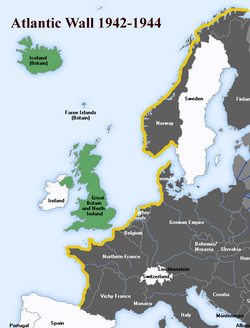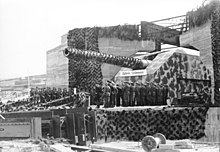Atlantic Wall
The Atlantic Wall (German: Atlantikwall) was an extensive system of Coastal fortifications built by Nazi Germany between 1942 and 1944 along the western coast of Europe as a defense against an anticipated Allied invasion of the mainland continent from Great Britain.[1]
| Atlantic Wall | |
|---|---|
| Part of the Third Reich | |
| Western Coast of Europe | |
 The Atlantic Wall, shown in yellow | |
| Site information | |
| Open to the public | Yes |
| Condition | Partially demolished, mostly intact |
| Site history | |
| Built | 1942–1944 |
| In use | 1942–1945 |
| Battles/wars | World War II |




Construction
On March 23, 1942 Führer Directive Number 40 called for the official creation of the Atlantic Wall. After the St. Nazaire Raid, on April 13, 1942 Adolf Hitler ordered naval and submarine bases to be heavily defended. Fortifications remained concentrated around ports until late in 1943 when defences were increased in other areas.[2]
Organisation Todt, which had designed the Siegfried Line (Westwall) along the Franco-German border, was the chief engineering group responsible for the design and construction of the wall's major fortifications. Thousands of forced laborers were impressed to construct these permanent fortifications along the Dutch, Belgian and French coasts facing the English Channel.
Early in 1944, Field Marshal Erwin Rommel was assigned to improve the Wall's defences. Rommel believed the existing coastal fortifications were entirely inadequate and he began strengthening them. He knew that the beaches between were barely defended, and the Allies could land there and capture the ports from the land. Under his direction, a string of reinforced concrete pillboxes were built along the beaches, or sometimes slightly inland, to house machine guns, anti-tank guns, and light artillery. Mines and antitank obstacles were planted on the beaches themselves, and underwater obstacles and mines were placed in waters just off shore.[3] The intent was to destroy the Allied landing craft before they could unload.
The Germans laid almost six million mines in northern France. More gun emplacements and minefields extended inland, along roads leading away from the beaches. In likely landing spots for military gliders and paratroopers, the Germans installed slanted poles with sharpened tops, which the troops called Rommelspargel ("Rommel's asparagus"). Low-lying land near rivers was flooded, as well.
Rommel firmly believed that Germany would inevitably be defeated unless the invasion could be stopped at the beach.
Although the defensive wall was never completed the Wall's existence was used to address concerns of the Soviet Union for why the Second Front was not opened until June 6, 1944 (less than a year before the end of the war). The Wall primarily consisted of batteries, bunkers, and minefields, which during 1942–1944, stretched from the French-Spanish border to Norway (Festung Norwegen). Many bunkers still exist, for example near Scheveningen, Den Haag, Katwijk and in Normandy. In Oostende, Belgium the public may visit a well-preserved part of the defences. That section consists of emplacements of the "Saltzwedel neu battery" and the "Stützpunkt Bensberg", consisting of several men’s quarters and the necessary facilities. These constructions were used by a unit of German military engineers (Pionierstab) who were in charge of bunker construction.
The Channel Islands were heavily fortified, particularly the island of Alderney which is closest to England (Jersey being the closest to France). Hitler had decreed that one twelfth of the steel and concrete used in the Atlantic Wall go to the Channel Islands, because they were British territory. Despite the mooting of Operation Constellation et al., the Allies bypassed the islands and did not try to liberate them when they invaded Normandy. The islands' German garrisons did not surrender until 9 May 1945 – one day after the German armed forces on the mainland. The German garrison on Alderney did not surrender until 16 May.
Walcheren Island was considered to be the "strongest concentration of defences the Nazis had ever constructed."[4]
Atlantic Wall Commands
The Atlantic Wall was not a single organisation except in the administration of its building. Militarily it was divided into eight commands:[5]
- Norway Army Command
- Forces Commander in Danmark
- Deutschen Bucht Command
- Wehrmacht Netherlands Command
- Armee Oberkommando 15 (15th Army zone)
- Armee Oberkommando 7 (7th Army zone)
- Armee Oberkommando 1 (1st Army zone)
- Armee Oberkommando 19 (19th Army zone)
Atlantic Wall Fortresses
Many major ports and positions were made part of the Atlantic wall and received heavy fortifications, Hitler ordered them all to fight to the end [6] and some of them remained in German hands until the unconditional surrender of Axis Forces on May 8, 1945. Several of the port fortresses were resupplied by submarine after being surrounded by Allied forces. The defenders of these positions included Slavic soldiers and SS troops. [7]
| Location | Commander | Garrison | Details of Battle | Surrender | Allied Use |
|---|---|---|---|---|---|
| Cherbourg | General von Schlieben | 47,000 men in whole Cotentin Peninsula | Port wrecked by demolitions. Hitler refused to allow demolitions earlier in the year. | June 27, 1944 majority of strong points surrendered | Put back into use by Americans. Limited use by the middle of August |
| Saint-Malo/Dinard | Colonel von Aulock | 12,000+ men including paratroopers and SS | Port wrecked by demolitions. 300 men on the fortified island of Cézembre held out till September 2, 1944. The island controlled the approaches to the port | August 17, 1944. | Out of use for whole campaign |
| Alderney | – | One of the most heavily defended fortresses on the Atlantic Wall | May 16, 1945 | Surrendered a week after the official Nazi Surrender | |
| Brest | General Ramcke | 38,000+ men including the 2nd Parachute Division | Fighting began on August 25, 1944. Port was completely demolished | September 2, 1944 | – |
| Lorient | General Junck | 15,000 | – | May 8, 1945 | Not captured during the conflict |
| Quiberon Bay and Belle Île | General Fahrmbacher | 25,000 | – | – | – |
| St. Nazaire | General Junck | 35,000 | – | May 8, 1945 | Not captured during the conflict |
| La Rochelle/La Pallice | Admiral Schirlitz | Naval Units, 158th Reserve Infantry Division | – | May 8, 1945 | Surrendered after the conflict, following the Allied siege of La Rochelle |
| Le Havre | Colonel Wildermuth | 14,000 | Surrendered after 3 days of fighting | September 14, 1944 | Put back into action in October 1944 |
| Boulogne | General Heim | 10,000 | Fighting started on September 7, 1944 | September 22, 1944 | British opened the port again in October |
| Calais/Cap Gris-Nez | Lt Colonel Schroeder | 9,000 | Batteries at Cap Gris-Nez surrendered a few days earlier. Port heavily damaged | September 30, 1944 | Returned to service late November 1944 |
| Dunkirk | Admiral Friedrich Frisius | 12,000 from the 18th Luftwaffe Ground Division | Port isolated on September 13, 1944 | May 1945 | – |
| Ostend | – | – | No resistance given, port not heavily damaged | – | – |
| Zeebrugge | General Eberding | 14,000 | Held as part of the Scheldt Fortress denying access to the Port of Antwerp. Fighting started in Early October 1944 | November 1, 1944 | First shipment to Antwerp November 28, 1944. Eighty-five days after its capture.[8] |
| Scheldt Fortress | General Daser | 8,000 | Defended South Beveland and Walcheren Island. Fighting started in late October 1944 | November 6, 1944 | – |
References
German Publication (PhD) in military history
- Dr. Thorsten Heber: Der Atlantikwall 1940–1945. Band I Die Befestigung der Küsten West- und Nordeuropas im Spannungsfeld nationalsozialistischer Kriegführung und Ideologie. 564 Seiten, 157 Bildtafeln mit 535 Abb. BoD 2008, ISBN 9783837029796.
- Dr. Thorsten Heber: Der Atlantikwall 1940–1945. Band II Die Invasion – Die Atlantikfestungen 1944/45 – Der Atlantikwall in Deutschland, Dänemark, Norwegen – Kompendium Regelbauten. 504 Seiten, 196 Bildtafeln mit 670 Abb. BoD 2008, ISBN 9783837029802.
Further reading
- Kauffmann, J.E. and Jurga, Robert M. Fortress Europe: European Fortifications of World War II, Da Capo Press, 2002. ISBN 0-306-81174-X
Other websites

- AtlantikWall.co.uk
- AtlantikWall.dk
- The defences of the Atlantikwall at Omaha Beach Archived 2012-06-14 at the Wayback Machine
- Atlantikwall.fr
- Atlantikwall.net Archived 2009-10-27 at the Wayback Machine
- The Atlantikwall in Denmark[permanent dead link]
- Bunkertypes, maps, museums and others Archived 2011-02-15 at the Wayback Machine
- The Atlantic Wall Linear Museum Archived 2022-04-10 at the Wayback Machine
- Britannica Online
- Museumscenter Hanstholm Archived 2013-03-29 at the Wayback Machine
- Kristiansand Cannon Museum Archived 2012-01-03 at the Wayback Machine
- Vara Battery (Kristiansand, Norway)
- Fortress Alderney Archived 2008-08-21 at the Wayback Machine
- Information site about the Atlantikwall in the Netherlands, Haagse Bunker Ploeg Archived 2019-07-02 at the Wayback Machine
- Atlantikwall Museum Noordwijk, Site about the Atlantikwall Museum Noordwijk in the Netherlands
- Information about the open air museum in Ostend, Belgium. Archived 2008-05-01 at the Wayback Machine
- Festung Europa : Bunkers in the Atlantikwall Archived 2021-01-16 at the Wayback Machine
- Places of interest for the war tourist along Hitlers Atlantic Wall in Denmark and Norway (English) Archived 2020-11-10 at the Wayback Machine
- Fortifications in Denmark and Europe through a thousand years (Danish) Archived 2020-11-10 at the Wayback Machine
- The Atlantic Wall in North Brittany (Bretagne Nord), France. Shore & Beach, 2004, 72:4 10–12